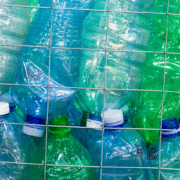What’s the deal with the Plastic Soup again?
March 15 2024 That’s what readers of news site nu.nl on their comment platform Nujij were wondering. In a recent […]
1 April 2022
The textile sector is one of the most polluting industrial sectors. On 30 March, Europe presented the long awaited European strategy for sustainable and circular textiles. The sector needs a complete overhaul. Sustainable will be the standard. This means that clothing and shoes must be repairable, resuable and recyclable. The strategy, which is part of the European Green Deal, looks ambitious.
For almost 10 years, Plastic Soup Foundation has been asking for measures to prevent synthetic microfibres from entering the environment during machine washing. Will the announced measures offer any solace?
According to the European Commission, about 60% of the fibres released during machine washing are synthetic. The fibres, just like microplastics that enter the environment and do not break down, are not the only problem though. Discarded nylon or polyester clothing cannot be, or hardly be, recycled. On top of this, the synthetic raw materials are so cheap that clothing can be sold for next to nothing. There is little time between successive collections, clothing is worn for only a short time and is then discarded. The mountain of waste is growing and raw materials are being wasted.
For the first time, it looks like this scenario of pollution and waste will be put to an end.
The European Commission is taking measures to avoid and reduce microplastics. It involves a wide range of measures. What is deemed important are the requirements that the design will be subject to. What these requirements entail is currently not clear, but clothing will be designed in such a way that they release few or no microplastics and can be worn for a long time. The standards will be announced later this year.
Other measures are:
Unfortunately there is still much uncertainty. What exactly will these measures entail, when will they take effect and, most importantly, how effective will they be? Plastic Soup Foundation will follow the case and advocate for binding measures that target the source.
Synthetic textile fibres are even made from PET (containers and bottles). Clothing concerns sometimes present this as sustainable. The European Commission calls these claims a large and growing concern. After all, this involves undesirable downcycling. New eco criteria should put an end to this. Instead of using PET as a raw material, the recycling of clothing fibres should be stimulated and gotten off the ground. It would then be better if the packaging industry uses its ‘own’ PET as a raw material for new packaging.
The Changing Markets NGO recently looked into the sustainability logos used by large textile brands. Its evaluation in License to greenwash is scathing. The logos give consumers the wrong impression, there is no control and no transparency. It looks like the European Commission, that is explicitly turning against greenwashing and fast fashion, will listen to the plea for legislation.
Apart from binding terms for eco design, efforts are being put into an extended producer responsibility. It will make textile manufacturers responsible for their products, even when they become waste. Each item of clothing will get its own Digital Product Passport.
The strategy has the potential to really make the textile industry more sustainable. Plastic Soup Foundation is extremely happy about this. However, the strategy must also include a guarantee that the amount of synthetic microfibres in the environment is not only reduced, but eventually also stops altogether. This aspect is currently missing.
Make the label count: textile labels should also inform users about microplastics
Come on EU! The massive dumping of discarded clothing in Ghana and Chile must stop
New report lays bare the fashion industry’s addiction to fossil fuels
Only prevention will effectively decrease the amount of plastic food packaging
March 15 2024 That’s what readers of news site nu.nl on their comment platform Nujij were wondering. In a recent […]
The first Impact Fair is Europe’s largest Impact Experience. An interactive ‘immersive’ experience of impactful examples.
The waste-export to countries outside of the EU has been restricted The Netherlands is against a carpet ban on shipping of plastic waste.
The waste-export to countries outside of the EU has been restricted The Netherlands is against a carpet ban on shipping of plastic waste.

 Recycled PET Plastic is not a safe packaging material for food and drink
Recycled PET Plastic is not a safe packaging material for food and drink